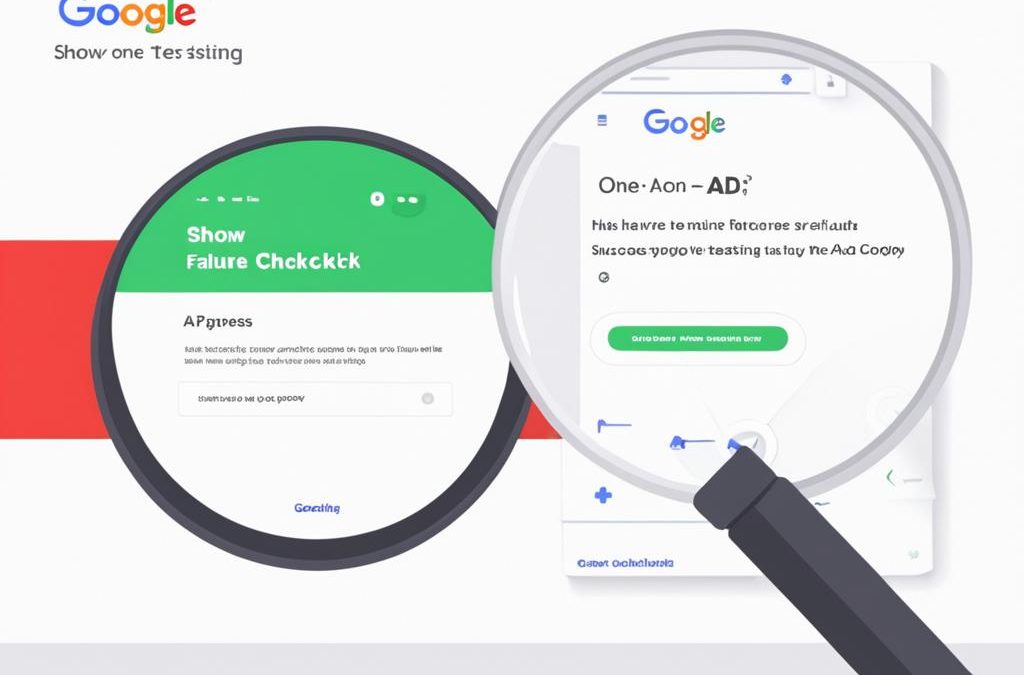Google is continuously working on improving its advertising platform to provide advertisers with more effective tools and strategies. One of the latest developments is the testing of ad copy variation without informing advertisers. This testing allows advertisers to make more informed decisions on which tactics generate a better return on investment.
The ability to test ad copy is crucial for advertisers to optimize their campaigns and improve performance. By testing different variations of ad copy, advertisers can identify what resonates best with their target audience and make data-driven decisions. However, it’s important to note that ad copy testing requires proper tools and implementation of best practices.
To access the ad copy testing feature on Google Ads, advertisers can create custom experiments from their original campaigns. These experiments can compare the performance of the experiment against the original campaign and allocate a percentage of the budget to the experiment. Custom experiments are available for Search, Display, Video, and Hotel Ads campaigns.
In order to improve ad copy performance, advertisers can utilize A/B testing methods. This involves creating two versions of an ad and measuring their effectiveness in achieving campaign goals. By analyzing the results, advertisers can identify the ad copy that generates better engagement and conversion rates.
Measuring the effectiveness of ad copy is essential for overall ad copy optimization. Advertisers should monitor key metrics such as click-through rates, conversion rates, and revenue generated to gauge the success of their ad campaigns. This data-driven approach allows advertisers to refine their ad copy strategies and optimize their campaigns accordingly.
Key Takeaways:
- Google is testing ad copy variation without informing advertisers to improve decision-making.
- Ad copy testing tools and best practices are crucial for optimizing ad performance.
- A/B testing allows advertisers to compare the effectiveness of different ad copy versions.
- Measuring ad copy effectiveness through key metrics helps in ad copy optimization.
- Continuous testing and optimization lead to better ad campaign performance on Google.
How to Set up a Custom Experiment
To set up a custom experiment on Google Ads, follow these steps:
- Go to the Campaigns section and click on Experiments.
- Click the plus button to create a new custom experiment.
- Select the original campaign you want to test.
- Provide a name and description for the experiment.
- Choose the percentage of the budget to allocate to the experiment.
- Schedule up to 5 experiments for a campaign, but only run one experiment at a time.
- Wait for the experiment’s ads to be reviewed and start running.
- Monitor the performance of the experiment and make changes as needed.
If you encounter any issues while creating an experiment, consider the following troubleshooting steps:
- Check if your original campaign has been removed.
- Remove any shared budgets.
- Choose dates that don’t overlap with other experiments.
- Ensure your campaign doesn’t have unsupported features.
- Resolve any policy issues with keywords.
By following these instructions and troubleshooting tips, you’ll be able to set up a custom experiment on Google Ads and start optimizing your ad copy effectively.

| Benefits of Setting up a Custom Experiment | Instructions |
|---|---|
| 1. Provides insights into the performance of your original campaign. | 1. Go to the Campaigns section and click on Experiments. |
| 2. Allows you to compare the performance of different ad variations. | 2. Click the plus button to create a new custom experiment. |
| 3. Helps in optimizing your ad copy for better results. | 3. Select the original campaign you want to test. |
| 4. Enables you to allocate a percentage of the budget specifically for the experiment. | 4. Provide a name and description for the experiment. |
| 5. Provides data for making informed decisions on improving campaign performance. | 5. Choose the percentage of the budget to allocate to the experiment. |
Different Types of Ad Copy Experiments
Google Ads offers various types of ad copy experiments that allow you to test and optimize your campaigns in different ways.
1. Ad Variations
Ad variations are a useful tool for testing modified ads against the original ads in your campaign. By creating variations of your ads, you can compare their performance and determine which version is more effective. If the modified ads show improved results, you can apply them to your campaign to maximize performance.
2. Custom Experiments
Custom experiments allow you to test various campaign settings to identify the most effective strategies for your goals. These experiments enable you to experiment with different elements such as Smart Bidding strategies, keyword match types, landing pages, audiences, and ad groups. By analyzing the performance of each experiment, you can make data-driven decisions to optimize your campaigns.
3. Video Experiments
If you run video ads on YouTube, video experiments can help you determine which ad versions perform better. By testing different videos, you can gain insights into their effectiveness in engaging your audience and driving results. This can help you refine your video ad strategy and allocate your budget effectively.
4. Performance Max Experiments
Performance Max experiments allow you to A/B test different features, settings, and campaigns across various channels, including Search, Display, and Video. By running these experiments, you can gain valuable insights into what works best for your specific marketing objectives. This can lead to improved overall performance and better ROI.
Understanding the results of your ad copy experiments is crucial for making informed decisions. Key experiment metrics such as click-through rates, conversion rates, and cost per conversion can provide valuable insights into the effectiveness of your ad variations or experiment settings. Analyzing these metrics allows you to identify successful strategies and apply them to your ongoing campaigns, leading to continuous improvement and better overall performance.
“Experimentation is key to optimizing your ad copy and achieving better results. By leveraging different types of experiments, you can uncover insights that help you create more effective campaigns.”
Now that you’re familiar with the different types of ad copy experiments available, it’s time to explore how to interpret the results of these experiments. This will help you make well-informed decisions for your ongoing campaigns and drive better performance.
How to Interpret Experiment Results
When conducting experiments in Google Ads, interpreting the results is crucial in understanding the performance of your ad copy and determining the effectiveness of your campaign. The experiments table provides valuable information to guide your decision-making process.
The experiments table in Google Ads displays the name, type, status, and results of each experiment. It allows you to compare the performance of the control campaign with the treatment campaign. The results column indicates which campaign performed better, providing insights into the impact of the tested changes.
The status column in the experiments table notifies you about the current state of each experiment. It indicates whether the experiment is in progress, complete and applied, or scheduled. This information helps you track the progress and status of your experiments.
To evaluate the effectiveness of your ad copy, additional metrics can be added to the experiments table. These metrics provide a comprehensive analysis of your experiment and enable you to measure the impact of different variables on your campaign’s performance.
Interpreting experiment results involves evaluating experiment metrics and determining the success of your experiments. By analyzing the data provided in the experiments table, you can gain valuable insights into the performance of your ad copy and make informed decisions regarding the changes to be applied to your original campaign.
Evaluating Experiment Metrics
When evaluating experiment metrics, consider the following factors:
- Click-through rate (CTR): A higher CTR indicates that the ad copy is engaging and effective in attracting user attention.
- Conversion rate: A higher conversion rate suggests that the ad copy is persuasive and compelling, leading users to take the desired action.
- Cost per conversion: A lower cost per conversion signifies better efficiency in ad spend, indicating that the ad copy is generating results at a lower cost.
- Return on ad spend (ROAS): A higher ROAS demonstrates the effectiveness of the ad copy in generating revenue and maximizing the return on investment.
By analyzing these metrics and considering the experiment results, you can determine the success of your experiments and make data-driven decisions to optimize your ad copy performance.

| Experiment Name | Type | Status | Results |
|---|---|---|---|
| Experiment 1 | Custom Experiment | Complete and Applied | Treatment campaign performed better |
| Experiment 2 | Ad Variations | In Progress | Control campaign performed better |
In the example above, Experiment 1 was a custom experiment that has been completed and applied. The treatment campaign outperformed the control campaign, indicating that the changes made in the experiment had a positive impact. Experiment 2, which involved ad variations, is still in progress, with the control campaign currently performing better.
Interpreting experiment results allows you to make data-driven decisions and optimize your ad copy performance. By analyzing metrics and understanding experiment status, you can refine your campaigns and drive better results.
Optimizing Ad Copy for Local Search Ads
Google is currently conducting experiments with Local Search Ads, which aim to promote verified business locations in local search results without relying on keywords. While advertisers cannot request to participate in these experiments at the moment, this development presents an opportunity to target local searchers more effectively and optimize ad copy specifically for local searches.
To optimize ad copy for local search ads, advertisers should focus on implementing locally-focused strategies and optimizations. Some recommended approaches include:
- Activating or deactivating location extensions based on the geographical areas you want to target.
- Utilizing the information provided in your Google My Business (GMB) account to trigger relevant results for local searches.
The introduction of new features in Google My Business, such as business descriptions and services listings, offers additional signals for triggering ads in local searches. Leveraging these features can significantly enhance the performance of your local ad campaigns.
To illustrate the potential impact of optimizing ad copy for local search ads, consider the following example:
A local bakery wants to attract more customers from nearby neighborhoods. By activating location extensions and optimizing their Google My Business account to include detailed information about their bakery, such as opening hours, popular products, and customer reviews, they can increase the visibility of their ads in local search results. This can drive more targeted traffic to their website or physical store, ultimately resulting in higher conversions and revenue.
| Local Search Ad Optimization Strategies | Benefits |
|---|---|
| Activate location extensions | Increase visibility in local search results |
| Optimize Google My Business account | Trigger relevant results for local searches |
| Utilize new GMB features | Enhance ad performance in local searches |
The Importance of GMB Optimization for Local Searches
Optimizing Google My Business (GMB) is crucial for achieving high rankings in local searches. By harnessing the power of GMB, businesses can provide essential information to Google, enabling the search engine to deliver relevant local results to searchers. The introduction of business descriptions and services listings in GMB has further enhanced the optimization opportunities, allowing businesses to showcase their offerings and attract local customers.
GMB optimization plays a significant role in improving local ad performance. With the inclusion of structured pricing information for services, businesses can provide transparency to potential customers, assisting in their decision-making process. Just as optimizing product feeds enhances visibility and relevance in Google Shopping results, careful optimization of GMB can significantly impact local search rankings and overall ad performance.
GMB optimization not only boosts local search rankings but also enhances the overall online presence of a brand. By ensuring that GMB listings reflect accurate and up-to-date information, businesses can build trust and credibility with potential customers.
When optimizing GMB for local searches, consider including relevant keywords in your business description and services listings. This can help Google understand the nature of your business and match it with relevant search queries. Additionally, it is essential to regularly monitor and update your GMB profile, ensuring that all information is accurate and consistent across multiple platforms.
By maximizing GMB optimization for local searches, businesses can increase their visibility, attract more local customers, and ultimately drive conversions. The power of GMB cannot be underestimated in today’s competitive digital landscape, making it an essential tool for businesses looking to thrive in local markets.
Potential Motives Behind Local Experiment Campaigns
The motive behind the local experiment campaigns and the updates to Google My Business can be seen from different perspectives. The lack of keywords in local campaigns offers advertisers the possibility to target local searchers without relying on existing campaigns and active keywords. The updates to Google My Business provide Google with more information to match ads with relevant searches. It is unclear if these local experiment campaigns will continue or if there are alternative motives at play. However, optimizing the new details in GMB is essential for ranking in local searches and taking advantage of any future developments in local advertising.
Conclusion
Ad copy testing on Google is a valuable strategy for advertisers looking to improve their campaign performance. With various types of experiments available, including ad variations, custom experiments, video experiments, and performance max experiments, advertisers can test different settings, optimize their ad copy, and measure effectiveness.
By taking advantage of these testing opportunities, advertisers can make more informed decisions and enhance their campaigns for local searches through Google My Business. Optimizing their Google My Business profiles by leveraging features like business descriptions and services listings can improve their visibility and relevance in local searches.
While the future of local search ads and monetization on Google remains uncertain, focusing on Google My Business optimization is a proactive approach that can lead to better results in local ad performance. By staying informed about updates and new developments, advertisers can stay ahead of the curve and maximize their advertising impact.
FAQ
What is ad copy testing and why is it important?
Ad copy testing is the process of experimenting with different variations of ad copy to measure their effectiveness and optimize campaign performance. It allows advertisers to determine which tactics generate a better return on investment and make data-driven decisions. Ad copy testing can help improve click-through rates, conversion rates, and overall ad performance.
How can I test ad copy on Google?
Google provides various tools and features to test ad copy. One way is through custom experiments on Google Ads, where you can create different versions of your original campaigns and compare their performance. You can also use ad variations to test modified ads against the original ads and apply the modifications if they perform better. Additionally, you can conduct video experiments to determine the effectiveness of different video ads on YouTube or run performance max experiments to A/B test different features, settings, and campaigns.
How do I set up a custom experiment on Google Ads?
To set up a custom experiment, go to the Campaigns section in Google Ads and click on Experiments. Then, click the plus button to create a new custom experiment. Select the original campaign you want to test, provide a name and description for the experiment, and choose the percentage of the budget to allocate to the experiment. You can schedule up to 5 experiments for a campaign but only run one experiment at a time.
What are the different types of ad copy experiments on Google?
Google offers ad variations, custom experiments, video experiments, and performance max experiments. Ad variations allow you to test modified ads against the original ads. Custom experiments are used to test various campaign settings and elements. Video experiments help determine the effectiveness of different video ads on YouTube. Performance max experiments allow you to A/B test various features, settings, and campaigns to improve results.
How can I interpret the results of my ad copy experiments?
The experiments table in Google Ads provides information on the results of your experiments, including the name, type, status, and results. The results column indicates whether the control or treatment campaign performed better. The status column shows whether the experiment is in progress, complete and applied, or scheduled. Additional metrics can be added to the table to analyze ad copy performance. It’s important to interpret the results to make informed decisions on applying changes to the original campaign.
How can I optimize ad copy for local search ads?
To optimize ad copy for local search ads, you can activate or deactivate location extensions, utilize Google My Business information to trigger relevant results, and focus on locally focused optimizations. Google My Business optimization is crucial for ranking well in local searches. The introduction of business descriptions and services listings in Google My Business allows businesses to provide important information to Google, improving relevance for local searches.
Why is Google My Business optimization important for local searches?
Optimizing Google My Business is essential for ranking well in local searches. The new features, such as business descriptions and services listings, provide additional signals for triggering ads in local searches. By optimizing the details in Google My Business, including services and structured pricing information, businesses can improve local ad performance and increase their visibility and relevance in local searches.
What are the potential motives behind local experiment campaigns?
The motives behind local experiment campaigns can be seen from different perspectives. The lack of keywords in local campaigns offers advertisers the possibility to target local searchers without relying on existing campaigns and active keywords. The updates to Google My Business provide Google with more information to match ads with relevant searches. The future of local experiment campaigns and the monetization of local search ads remain uncertain, but optimizing the new details in Google My Business is essential for ranking well in local searches and taking advantage of any future developments in local advertising.
What is the importance of ad copy testing on Google?
Ad copy testing on Google is a valuable strategy for improving campaign performance and optimizing ad copy. It allows advertisers to measure the effectiveness of different ad variations, experiment with various settings and elements, and make data-driven decisions. By conducting ad copy testing, advertisers can improve click-through rates, conversion rates, and overall ad performance, leading to better returns on investment.








